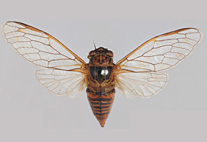Abstract
In 2012, Moulds established the morphologically similar cicada genera Simona and Chelapsalta, each with one Australian species (sancta Distant and puer Walker, respectively). In this paper, two new species are described within the genus Simona Moulds 2012, S. erema sp. nov. and S. retracta sp. nov., and one within the genus Chelapsalta Moulds 2012, C. myoporae sp. nov. The type species of Simona (female holotype), S. sancta (Distant, 1913), is redescribed based on a contemporary male, nominated a plesiotype, held in the Australian National Insect Collection. Melampsalta subgulosa Ashton 1914 is supported as a junior synonym of S. sancta. The species within the two genera of Simona and Chelapsalta are morphologically very similar. S. erema occurs widely through the arid regions of inland Australia, extending west from western Queensland through the Northern Territory, to central-western Western Australia, a linear distance of approximately 2200 km. S. retracta is known from a single semi-arid locality in southern inland Queensland. C. myoporae occurs widely through southeast, central and southwest Queensland, extending southwards into inland and western N.S.W. and southeastern South Australia. It tends to occur most commonly within vegetation associated with seasonal riverine floodplains, and in some areas of poorly drained and clay-rich soils. The calling songs of these three species, together with those of S. sancta and C. puer, are described. Detailed comparisons made of the songs of S. erema and C. myoporae, each from three widely separated locations, clearly exhibit structural consistency in their calling songs across their distributions. The Simona songs are complex and contain multiple elements; the species are very mobile and wary, and inhabit low dense shrubland. The songs of the two Chelapsalta species, both relatively sedentary in behaviour, in contrast consist of relatively uniform chirping and buzzing elements. It is suggested that, although the two genera are morphologically similar, the calling songs, behaviour and habitats do distinguish them, at least as represented by these species documented. MaxEnt modeling of the species climatic envelope for the widely distributed species Simona erema suggests an association with summer-peak rainfall and diurnal temperature range. Modeling under estimated conditions of the Last Glacial Maximum (22 ky) suggests the possibility of an even more widespread distribution at that time.

